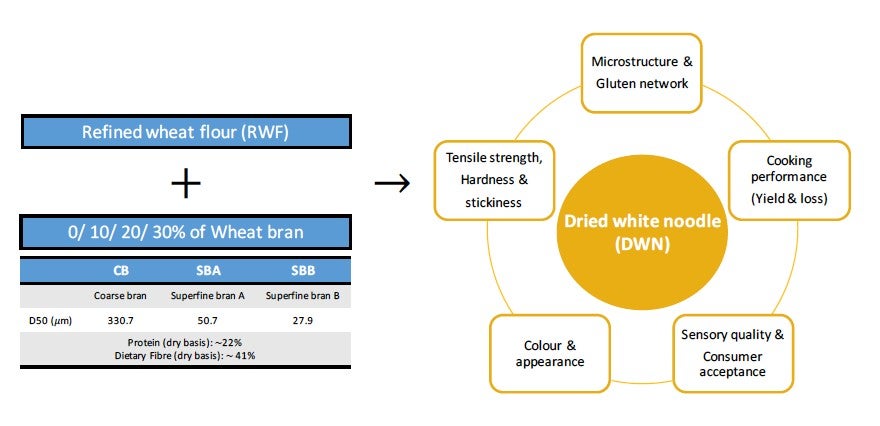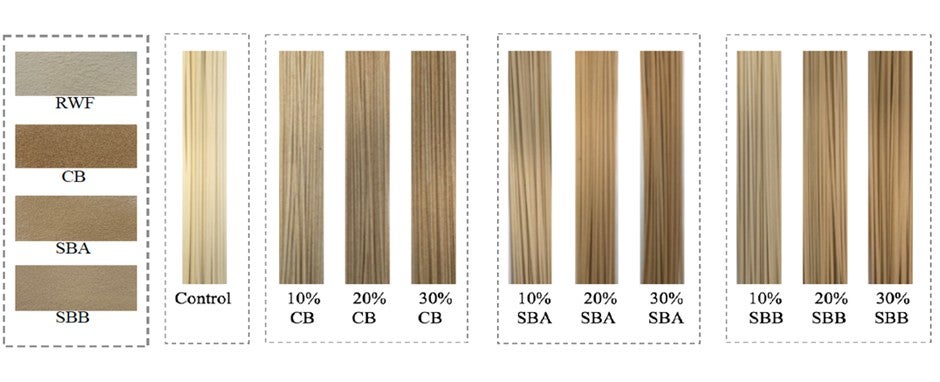Noodles enriched in dietary fibre by advanced technology remains tasty
ZHOU Weibiao (Group Leader, Food Science and Technology) May 03, 2021NUS food scientists have demonstrated that finely ground wheat bran can be added to Asian wheat noodles by up to 20% without compromising organoleptic acceptance. This can be an effective approach to promote higher dietary fibre intake.
Wheat bran is widely used in the food industry to produce fibre-rich food products with enhanced health benefits. The bran which is the hard outer layer of the wheat kernel is an excellent source of fibre and is rich in various nutrients. However, it is typically removed during processing as its presence in food products makes them less refined in texture and its taste may not appeal to most consumers.
A research team led by Prof ZHOU Weibiao from the Department of Food Science and Technology, National University of Singapore studied the effect of bran size reduction on the microstructure and performance of bran-enriched dried white noodle (see Figures). The researchers used superfine grinding to produce wheat bran powder at the micro-scale level and used them in making white noodle products. The results show that superfine grinding does not necessarily improve all aspects of noodle processing and cooking, but promote an overall improvement in the sensory quality of bran-enriched noodle. They also found through sensory evaluation that it is possible to produce bran-enriched noodle with relatively high bran levels (up to 20%) that are still deemed acceptable by consumers.
Superfine grinding is a relatively new food processing technology. There is limited research on the food quality and consumer sensory acceptance of superfine ground wheat bran and its end products. This study assessed the quality of bran-enriched noodles using both analytical instruments and human subjects. The wheat bran was ground into three categories of different granular sizes: coarse bran (diameter ~330.7 μm), superfine bran A (diameter ~50.7 μm) and super fine bran B (diameter ~27.9 μm). These were then added to refined wheat flour in varying quantities (from 10% to 30%) to make the noodles. With more wheat bran added, the dried white noodle quality deteriorated in all aspects. When the amount of bran added reached 30%, the noodles presented a highly obstructed or disrupted microstructure. Their appearance and taste were also least favoured by the consumers. Superfine grinding acted as an effective approach to alleviate the negative effect of wheat bran on noodle, particularly for various sensory attributes.
Ms JIN Xiaoxuan, a PhD student on the team said, “The study results contribute to a better understanding of the applicability of superfine grinding in improving the functionality of wheat bran, and will guide future development of bran-enriched products to stimulate consumer’s dietary fibre intake.”
Prof Zhou said, “While the consensus among the scientific community is that dietary fibre intake needs to be significantly boosted to combat a variety of chronic diseases in modern society, the perceived health benefits are insufficient for consumers to sacrifice their taste for “healthier” alternatives. Innovative food technologies are needed to make healthier food tasty and for tasty foods to become healthier. Deeper understanding on how healthier foods function when they go through the digestive system is fundamental in achieving this goal.”
Moving on, the research team plans to focus on the effect of wheat bran fortification on the oral processing and glycaemic index (GI) of noodles using both in vitro and in vivo approaches.
 Figure 1: Graphical representation of (left) experimental parameters and (right) attributes studied as part of this research.
Figure 1: Graphical representation of (left) experimental parameters and (right) attributes studied as part of this research.
 Figure 2: Photo showing the initial colour of raw ingredients and resulting noodle samples. The colour of the noodles is an important quality trait because of the visual impact at the point of sale. Legend: RWF = refined wheat flour, CB = coarse bran, SBA = superfine bran A, SBB = superfine bran B (ground to a finer size compared to SBA). [Credit: Food and Bioprocess Technology]
Figure 2: Photo showing the initial colour of raw ingredients and resulting noodle samples. The colour of the noodles is an important quality trait because of the visual impact at the point of sale. Legend: RWF = refined wheat flour, CB = coarse bran, SBA = superfine bran A, SBB = superfine bran B (ground to a finer size compared to SBA). [Credit: Food and Bioprocess Technology]
 Figure 3: Sensory attributes of cooked dried white noodles (DWN) fortified with (a) 10%, (b) 20%, and (c) 30% of wheat brans. All samples were graded on a scale of 1 to 9 against the control (DWN without addition of wheat brans) which is given a score of 5. A higher score means stronger intensity of the attribute/better than control, sample size is 44). Legend: CB, coarse bran; SBA, superfine bran A; SBB, superfine bran B (ground to a finer size compared to SBA). [Credit: Food and Bioprocess Technology]
Figure 3: Sensory attributes of cooked dried white noodles (DWN) fortified with (a) 10%, (b) 20%, and (c) 30% of wheat brans. All samples were graded on a scale of 1 to 9 against the control (DWN without addition of wheat brans) which is given a score of 5. A higher score means stronger intensity of the attribute/better than control, sample size is 44). Legend: CB, coarse bran; SBA, superfine bran A; SBB, superfine bran B (ground to a finer size compared to SBA). [Credit: Food and Bioprocess Technology]
Reference
Jin XX; Lin SY; Gao J; Wang Y; Ying J; Dong ZZ; Zhou W*, “Effect of Coarse and Superfine-ground Wheat Brans on the Microstructure and Quality Attributes of Dried White Noodle” FOOD AND BIOPROCESS TECHNOLOGY DOI: 10.1007/s11947-021-02621-2 Published: 2021.


